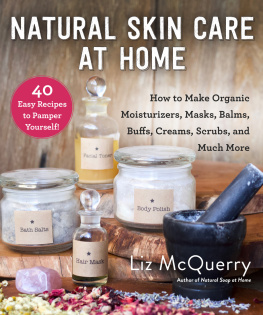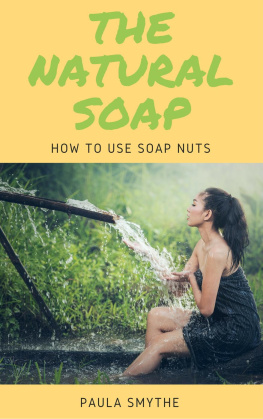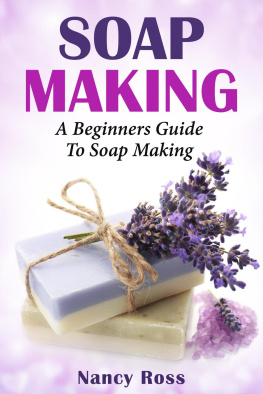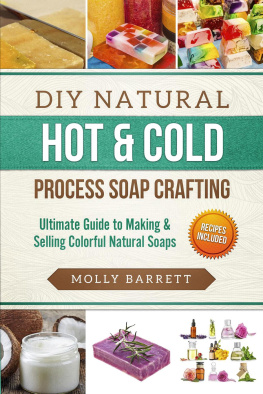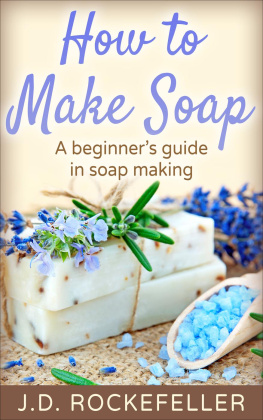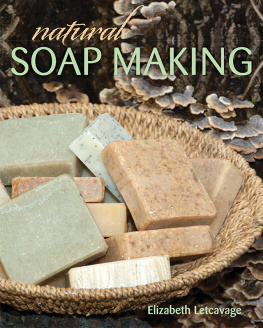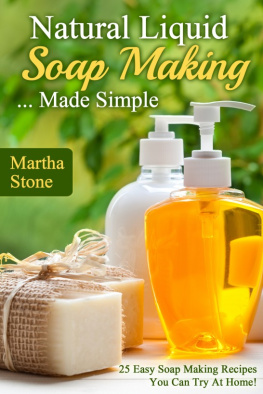Liz McQuerry - Natural Soap at Home
Here you can read online Liz McQuerry - Natural Soap at Home full text of the book (entire story) in english for free. Download pdf and epub, get meaning, cover and reviews about this ebook. year: 2018, publisher: Skyhorse Publishing, genre: Home and family. Description of the work, (preface) as well as reviews are available. Best literature library LitArk.com created for fans of good reading and offers a wide selection of genres:
Romance novel
Science fiction
Adventure
Detective
Science
History
Home and family
Prose
Art
Politics
Computer
Non-fiction
Religion
Business
Children
Humor
Choose a favorite category and find really read worthwhile books. Enjoy immersion in the world of imagination, feel the emotions of the characters or learn something new for yourself, make an fascinating discovery.
- Book:Natural Soap at Home
- Author:
- Publisher:Skyhorse Publishing
- Genre:
- Year:2018
- Rating:3 / 5
- Favourites:Add to favourites
- Your mark:
- 60
- 1
- 2
- 3
- 4
- 5
Natural Soap at Home: summary, description and annotation
We offer to read an annotation, description, summary or preface (depends on what the author of the book "Natural Soap at Home" wrote himself). If you haven't found the necessary information about the book — write in the comments, we will try to find it.
Natural Soap at Home — read online for free the complete book (whole text) full work
Below is the text of the book, divided by pages. System saving the place of the last page read, allows you to conveniently read the book "Natural Soap at Home" online for free, without having to search again every time where you left off. Put a bookmark, and you can go to the page where you finished reading at any time.
Font size:
Interval:
Bookmark:

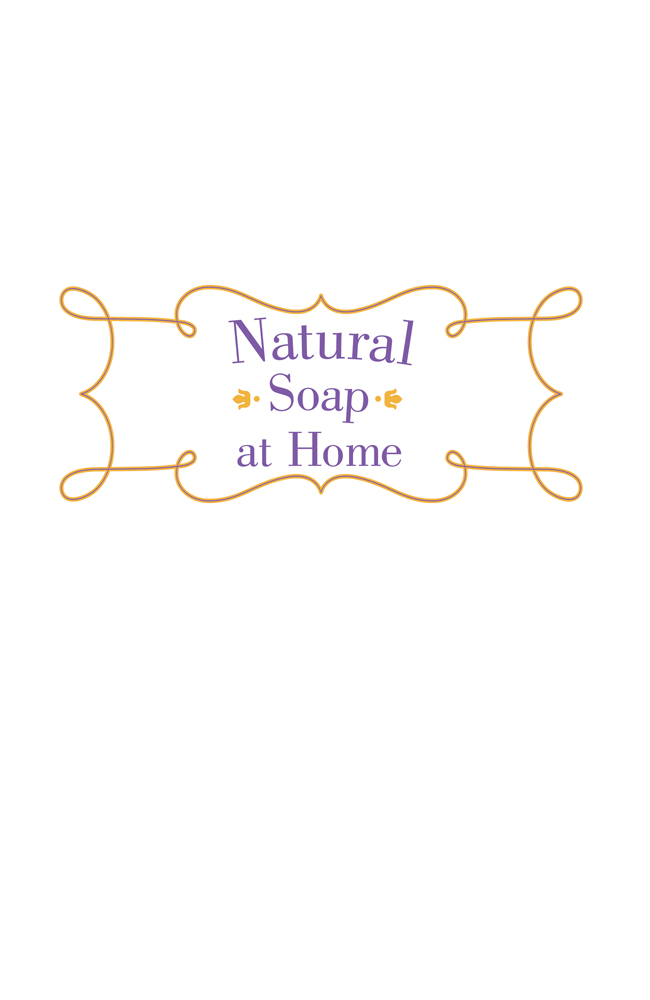
 Copyright 2018 by Liz McQuerry Photographs copyright 2018 by Liz McQuerry All rights reserved. No part of this book may be reproduced in any manner without the express written consent of the publisher, except in the case of brief excerpts in critical reviews or articles. All inquiries should be addressed to Skyhorse Publishing, 307 West 36th Street, 11th Floor, New York, NY 10018. Skyhorse Publishing books may be purchased in bulk at special discounts for sales promotion, corporate gifts, fund-raising, or educational purposes. Special editions can also be created to specifications. For details, contact the Special Sales Department, Skyhorse Publishing, 307 West 36th Street, 11th Floor, New York, NY 10018 or .
Copyright 2018 by Liz McQuerry Photographs copyright 2018 by Liz McQuerry All rights reserved. No part of this book may be reproduced in any manner without the express written consent of the publisher, except in the case of brief excerpts in critical reviews or articles. All inquiries should be addressed to Skyhorse Publishing, 307 West 36th Street, 11th Floor, New York, NY 10018. Skyhorse Publishing books may be purchased in bulk at special discounts for sales promotion, corporate gifts, fund-raising, or educational purposes. Special editions can also be created to specifications. For details, contact the Special Sales Department, Skyhorse Publishing, 307 West 36th Street, 11th Floor, New York, NY 10018 or .
Skyhorse and Skyhorse Publishing are registered trademarks of Skyhorse Publishing, Inc., a Delaware corporation. Visit our website at www.skyhorsepublishing.com. 10 9 8 7 6 5 4 3 2 1 Library of Congress Cataloging-in-Publication Data is available on file. Cover design by Mona Lin Cover photo credit iStock Print ISBN: 978-1-5107-3003-8 Ebook ISBN: 978-1-5107-3004-5 Printed in China Dedicated to Rhys, my delightful and constant co-conspirator in creativity and wonder. Contents
Contents 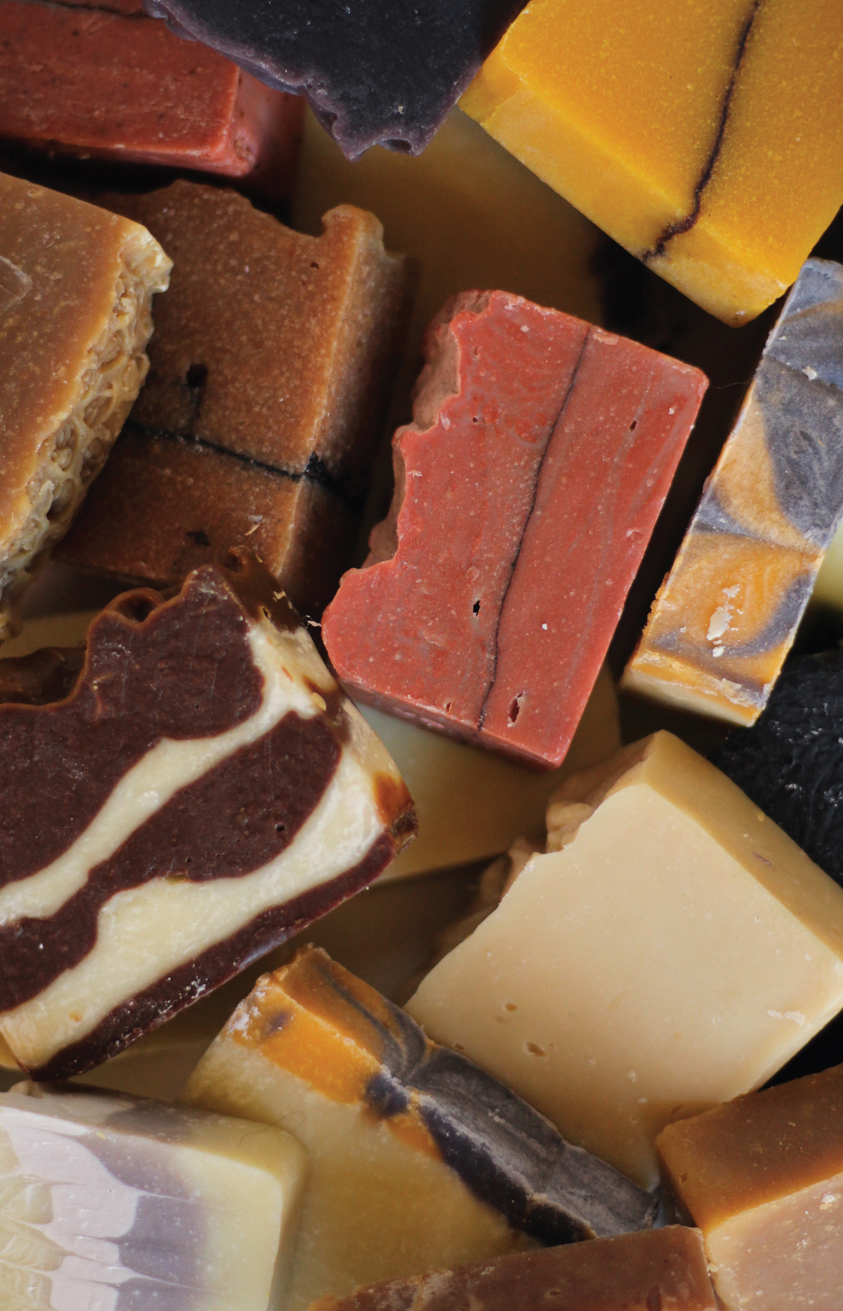 Everything You Need to Know First Handcrafting soap is one of the most satisfying ways to spend time in your kitchen. The return on joy and skincare alone makes it worthwhilenot to mention, its a way to spend time in your kitchen without adding to the size of your waist! I want to start with a brief (promise!) history of soapmaking, just so you know where soap came from and how it has transformed over the years to become the soap we all use today. Then well focus on pH, saponification, oil properties, and a few other values that need to be taken into consideration when crafting soap.
Everything You Need to Know First Handcrafting soap is one of the most satisfying ways to spend time in your kitchen. The return on joy and skincare alone makes it worthwhilenot to mention, its a way to spend time in your kitchen without adding to the size of your waist! I want to start with a brief (promise!) history of soapmaking, just so you know where soap came from and how it has transformed over the years to become the soap we all use today. Then well focus on pH, saponification, oil properties, and a few other values that need to be taken into consideration when crafting soap.
Dont worry if these concepts seem foreign and confusing; they are simply given as an understanding of the hows and whys in soapmaking language. Everything will make sense as you progress through your soap-crafting journey and youll be grateful for a solid foundation once you begin creating your own recipes. I also hope to help you avoid many a soap problem before they arise. We will also review some cautionary advice and safety precautionsdo not skip this section. Your future unscathed self will thank you. Finally, I will go over tools used and provide you with a short shopping list to get you started.
And then well get into the fun stuff: formulations, recipes, and ideas! A Brief History of Soap Soap has been around for a long time, of course. However, soap that doesnt scour off a good portion of your skin is a recent phenomenon. My mother has told me stories about washing out stains in her fathers work shirts with regular Tide when she was a child. Her skin would start burning off before she was finished. Ouch! (For the record, if your soap is doing this after curing time, you may wish to review and try again.) The oldest written record of soap comes from ancient Babylon. In 2800 B.C., the Babylonians were making soap from boiled fats and ashes.
At that time, soap was used for cleaning fibers and utensils, as well as medicine, but it hadnt been used on the body. In 1550 B.C., Egyptians were using alkaline salts blended with animal and vegetable oils to create a soap-like substance. In 600 B.C., the Phoenicians were using wood ash and goat tallow to create soap, and in the first century A.D., the Romans were making soap from urine. The Celts came up with a soap made from plant ash and animal fat and called it saipo, from which we get our modern word soap, although historically soap has also been said to have come from Mount Sapo in Rome. The Romans were well known for their soap crafting and bathhouses. When animals were sacrificed and burned on the altar, the burned ashes and fat traveled downhill and collected into pools.
These pools were soap! Later, bathhouses and soap fell right along with the rest of the Roman Empire and the practice of washing with soap was largely lost in Europe. This was followed by hundreds of years of filth, poor hygiene, and most notably, plagues. From the fourth to the tenth century, soap was once again manufactured in European countries, but only regularly used by the wealthy. Crafting soap was a coveted art, and soap makers were highly taxed, so the price of soap was high. Eventually, the soap- making process was mainstreamed, and in the 1800s, it became a more cost-effective commodity. As our knowledge of the chemistry of soap has increased, the soap we use for laundry has become separate from that used for the body, and we now have special soaps used for dishes, cars, and so on.
Liquid hand soaps were invented in 1970. Now you, too, can make your own soap. You wont even need to sacrifice any animals! In fact, most of the recipes in this book, the exceptions being the honey bee and goat milk soaps, are vegan. A BIT ABOUT pH Why do you need to know about pH to create a perfect bar of soap? pH stands for potential of hydrogen or power of the hydrogen ion and refers to whether a substance is either acid, alkaline, or neutral, which is measured on a pH scale. This is very important in soapmaking because when it comes to soap for your skin, you certainly dont want to be peeling it off. You just want to remove grime while retaining oils.
Human skins natural pH is around 7. When making soap, we want it to be slightly alkali because that assists in cleaning skin and destroying the bad bacteria that cause odors or acne while retaining the nourishment that skin needs.  So it is really important that the soap we craft comes to a pH between 8 and 10. Over 10 becomes clothing detergent and then pure sodium hydroxide very quickly. The chart on this spread gives a nice visual of the pH scale: at one end, you have acid and the other end, you have alkaline. The middle ground is what we aim for in soapmaking, as that is the baseline of healthy human skin pH.
So it is really important that the soap we craft comes to a pH between 8 and 10. Over 10 becomes clothing detergent and then pure sodium hydroxide very quickly. The chart on this spread gives a nice visual of the pH scale: at one end, you have acid and the other end, you have alkaline. The middle ground is what we aim for in soapmaking, as that is the baseline of healthy human skin pH.
You will always want to test your soap after it has cured (curing takes four to six weeks) to ensure the pH balance is within an acceptable range. To do this, you can purchase pH testing strips; these work by blending a little bit of distilled water into a sample of your soap and dipping the paper in. The paper will change color, or not, according to the soaps pH levels. Another method that many soap makers use is the zap test. All you do here is lightly taste your soap with the tip of your tongueif you feel nothing, your soap is at a good pH. However, if you feel a zap, that is the lye, meaning the pH is too high.
You can also test with purple cabbage. To use this method, simply chop up a few pieces of purple cabbage and toss into your blender. Add about a cup of distilled water and blend until you have a nice mixture. Now strain out the water and compost the cabbage. Drip a small amount of your cabbage water onto your soap; the purple cabbage drops will quickly change color. Check the color against a pH color scale.
Next pageFont size:
Interval:
Bookmark:
Similar books «Natural Soap at Home»
Look at similar books to Natural Soap at Home. We have selected literature similar in name and meaning in the hope of providing readers with more options to find new, interesting, not yet read works.
Discussion, reviews of the book Natural Soap at Home and just readers' own opinions. Leave your comments, write what you think about the work, its meaning or the main characters. Specify what exactly you liked and what you didn't like, and why you think so.


